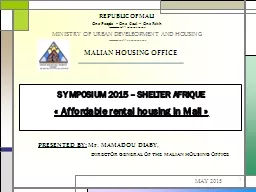PPT-REPUBLIC OF MALI
Author : cheryl-pisano | Published Date : 2016-07-02
One People One Goal One Fai th MINISTRY OF URBAN DEVELEOPMENT AND HOUSING MALIAN HOUSING OFFICE SYMPOSIUM 2015 SHELTER AFRIQUE
Presentation Embed Code
Download Presentation
Download Presentation The PPT/PDF document "REPUBLIC OF MALI" is the property of its rightful owner. Permission is granted to download and print the materials on this website for personal, non-commercial use only, and to display it on your personal computer provided you do not modify the materials and that you retain all copyright notices contained in the materials. By downloading content from our website, you accept the terms of this agreement.
REPUBLIC OF MALI: Transcript
Download Rules Of Document
"REPUBLIC OF MALI"The content belongs to its owner. You may download and print it for personal use, without modification, and keep all copyright notices. By downloading, you agree to these terms.
Related Documents














